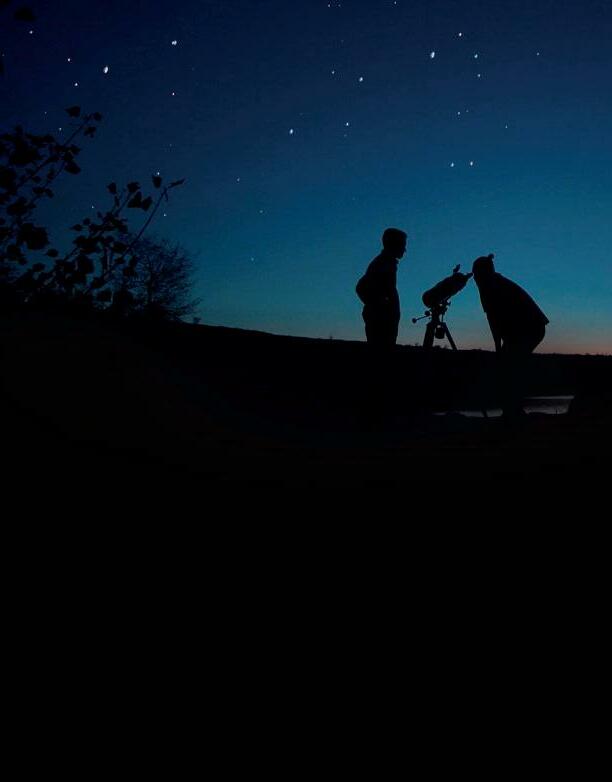
5 minute read
Esprimi un desiderio
Make a wish
di /by Paola De Cassan
Advertisement
L’amor che move il sole e l’altre stelle” scriveva Dante indicando che la chiave di tutto del mistero della vita e dell’universo fosse l’amore. E così ogni anno si resta incantati di fronte a una delle tante meravigliose bellezze che la natura ci offre come il cielo di agosto e le sue lacrime di San Lorenzo. Ma perché questo fenomeno appare sempre nello stesso periodo di ogni anno? Perché come ben sappiamo la Terra, girando attorno al Sole, più o meno nello stesso periodo, attraversa una scia di frammenti lasciati dai passaggi della cometa periodica Swift-Tuttle, fonte dell’annuale sciame meteorico delle Persiadi.
Quello che per gli studiosi dell’universo è solo uno dei tanti misteri da osservare e studiare, per noi diventa un momento da vivere estasiati con lo sguardo all’insù esprimendo un desiderio ogni qual volta riusciamo a intravedere queste suggestive scie luminose.
Per ammirare lo spettacolo al meglio, l’INAF consiglia di farlo a occhio nudo, osservando il fenomeno nelle ore più tarde della notte, scrutando il cielo in direzione della costellazione del Perseo, in direzione nord est, in uno spazio più ampio possibile, aperto, non in bosco e, ovviamente, lontano da fonti luminose.
Abbiamo chiesto a Sabina Viezzoli, guida naturalistica, alcuni suggerimenti sui luoghi facilmente raggiungibili per osservare le stelle sul Carso triestino.
Il luogo per eccellenza è nei dintorni dell’osservatorio astronomico di Basovizza, il parco degli Eroi: si raggiunge dal paese seguendo le indicazioni e offre un grande piazzale dove stendersi a terra o posizionare il telescopio per ammirare altre stelle.
Altri luoghi facilmente accessibili sono il parcheggio della ferrata “Le Rose d’inverno”, sempre nei dintorni di Basovizza ma nella zona della foiba, verso San Lorenzo, e la vedetta di San Lorenzo che sovrasta la Val Rosandra. Anche in questo caso c’è facilità di parcheggio e per un buon punto di osservazione basta fare alcuni passi.
La chiesetta di Monrupino è invece il luogo adatto per osservazioni con orizzonte ad est del tutto libero da rilievi.
Il picco di visibilità delle Perseidi, quest’anno, cade tra l’11 e il 13 agosto; purtroppo la luna piena del 12 agosto non consente di avere le condizioni ideali per ammirare le stelle cadenti, ma vi ricordiamo che il fenomeno è sempre visibile anche nelle settimane successive, seppur con minor frequenza.
ENGLISH TEXT
The love that moves the sun and the other stars” wrote Dante, indicating that the key to everything in the mystery of life and the universe was love. And so every year we are enchanted in front of one of the many marvellous beauties that nature offers us such
Ogni anno si resta incantati di fronte a una delle tante meravigliose bellezze che la natura ci offre come il cielo di agosto e le sue lacrime di San Lorenzo. — And so every year we are enchanted in front of one of the many marvellous beauties that nature offers us such as the August sky and its tears of San Lorenzo (shooting stars).
as the August sky and its tears of San Lorenzo (shooting stars). But why does this phenomenon always appear at the same time every year? Because, as we all know, the Earth, as it revolves around the Sun, more or less at the same time, passes through a trail of fragments left by the passage of the periodic comet Swift-Tuttle, the source of the annual Persiades meteor shower. What for the scholars of the universe is just one of the many mysteries to be observed and studied, for us becomes a moment to look up ecstatically and make a wish every time we catch a glimpse of these suggestive light streaks. To admire the spectacle at its best, the INAF recommends doing so with the naked eye, observing the phenomenon in the late hours of the night, scanning the sky in the direction of the constellation Perseus, in a north-easterly direction, in the widest possible space, open, not in the woods and, of course, away from light sources. We asked Sabina Viezzoli, a nature guide, for some suggestions on easily accessible places for stargazing in the Trieste Karst. The place par excellence is in the vicinity of the Basovizza astronomical observatory, the Parco degli Eroi (Heroes’ Park): it can be reached from the village by following the signs and has a large square where you can lie on the ground or set up your telescope to admire the stars. Other easily accessible places are the car park of the “Le Rose d’inverno” ferrata, also near Basovizza but in the area of the Foiba, towards San Lorenzo, and the San Lorenzo lookout over Val Rosandra. Here, too, there is easy parking and a good observation point is just a few steps away. The little church of Monrupino, on the other hand, is a suitable place for observations with the horizon to the east completely free of mountains. The peak visibility of the Perseids, this year, falls between 11 and 13 August; unfortunately the full moon on 12 August does not provide ideal conditions for admiring the shooting stars, but we would like to remind you that the phenomenon is always visible in the following weeks, albeit less frequently.
INAF

L’osservatorio astronomico di Trieste promuove, realizza e coordina attività di ricerca nei campi dell’astronomia e dell’astrofisica. Quest’anno, in occasione dei 100 anni dalla nascita dell’astrofisica Margherita Hack organizza nel periodo di giugno la conferenza internazionale dedicata (hack100.inaf.it). Durante l’anno organizza visite guidate e osservazioni per pubblico e scuole presso la specola Margherita Hack. –The Trieste Astronomical Observatory promotes, implements and coordinates research activities in the fields of astronomy and astrophysics. This year, on the occasion of the 100th anniversary of the birth of astrophysicist Margherita Hack, it organises a dedicated international conference in June (hack100. inaf.it). Throughout the year, it organises guided tours and observations for the public and schools at the Margherita Hack Observatory.
www.oats.inaf.it
Margherita Hack










